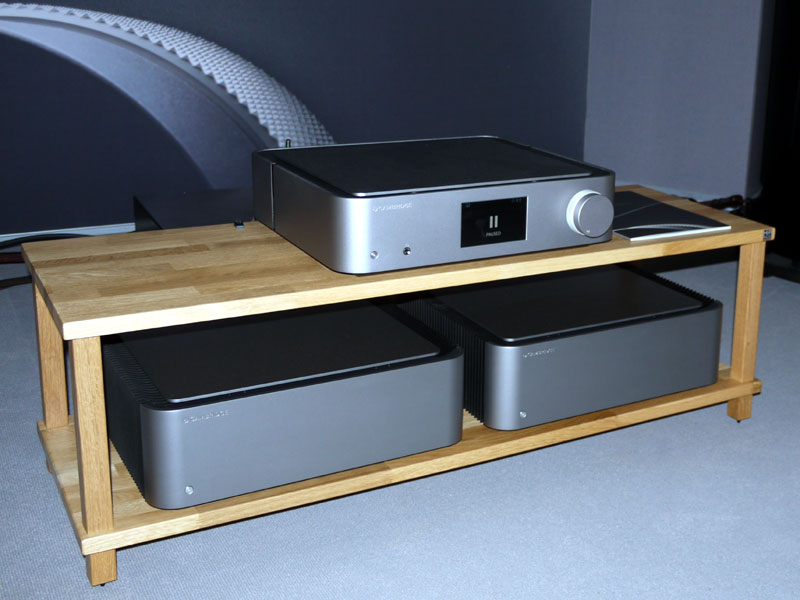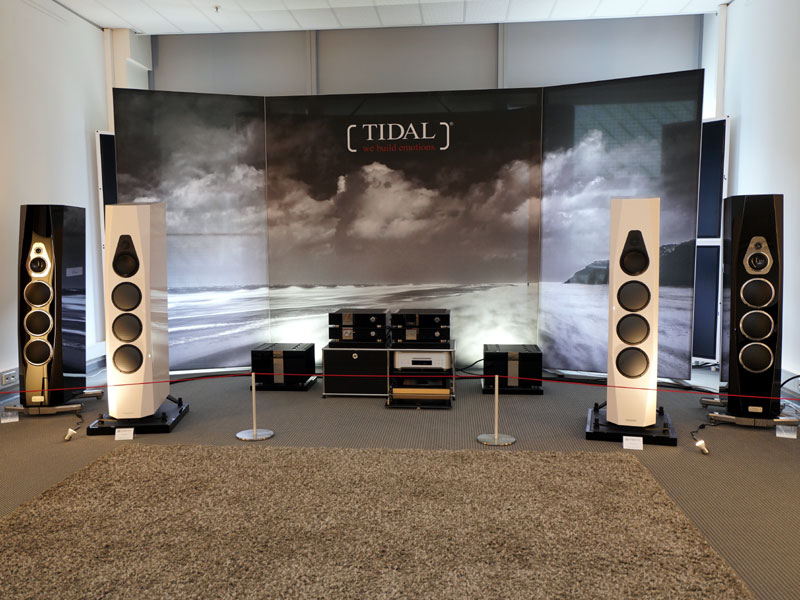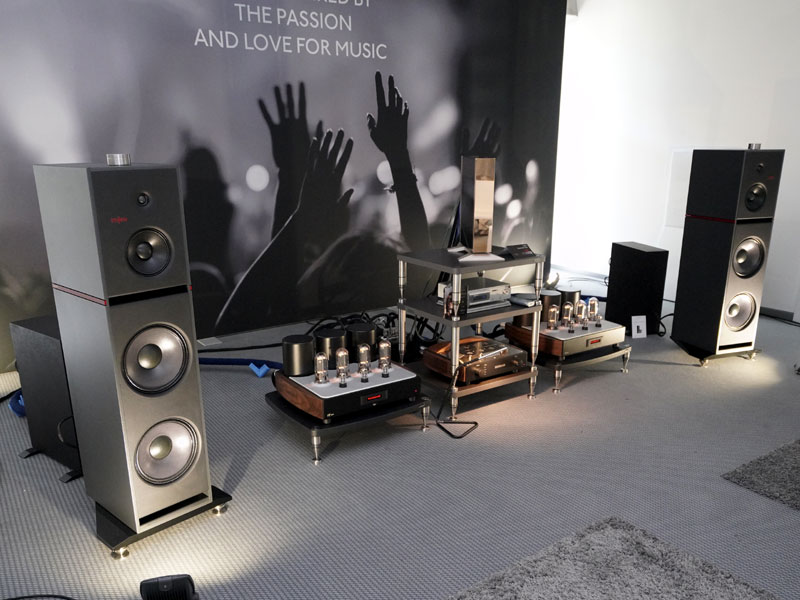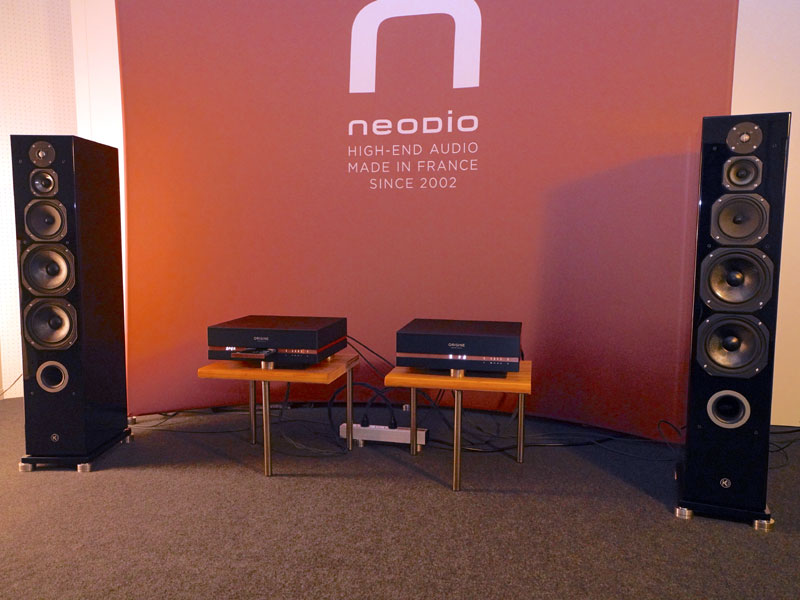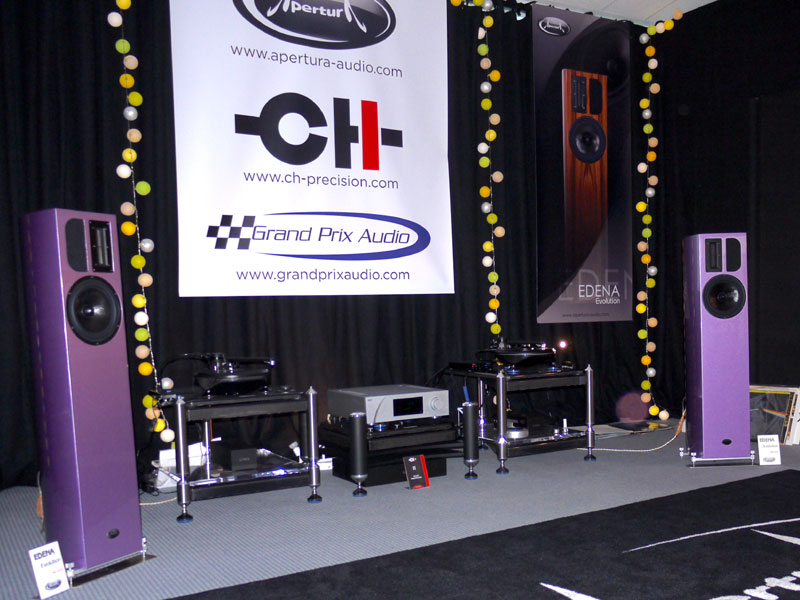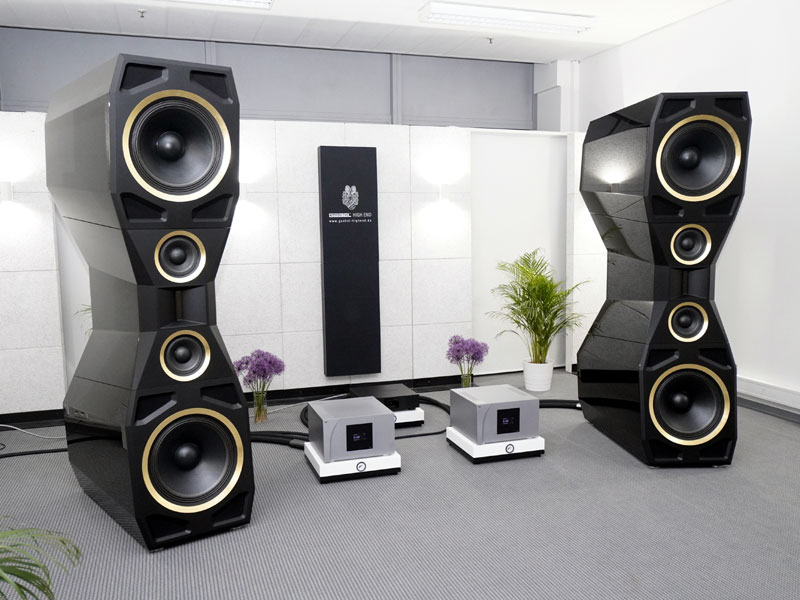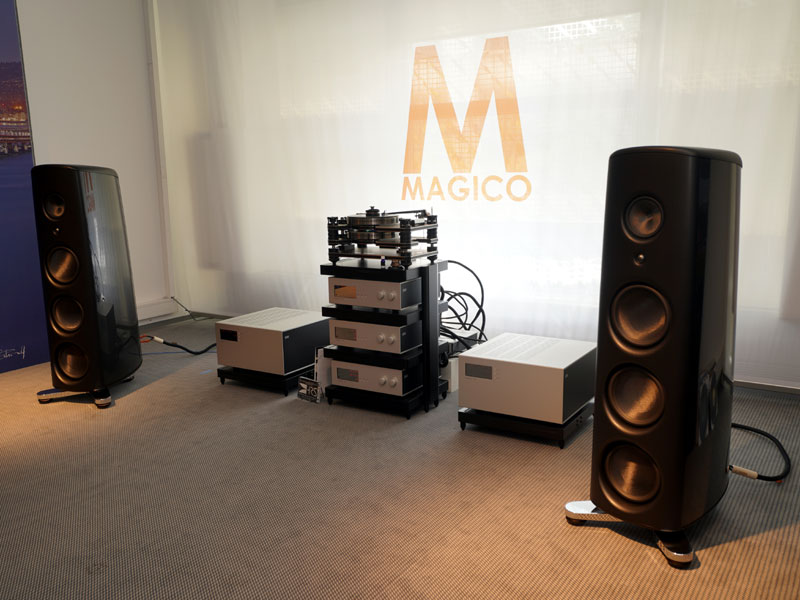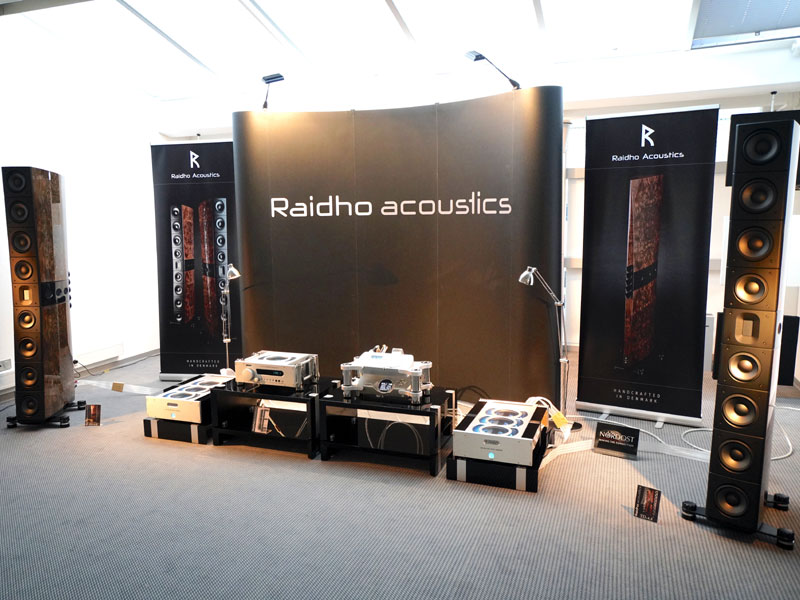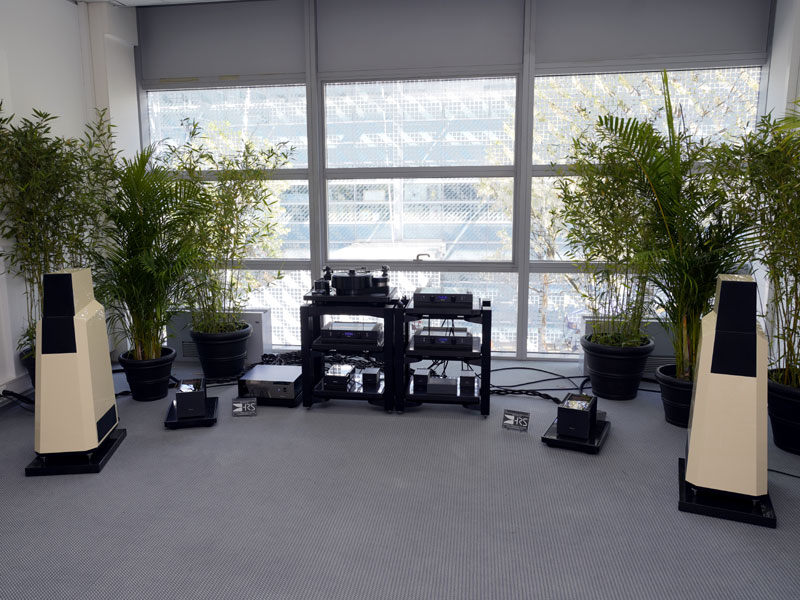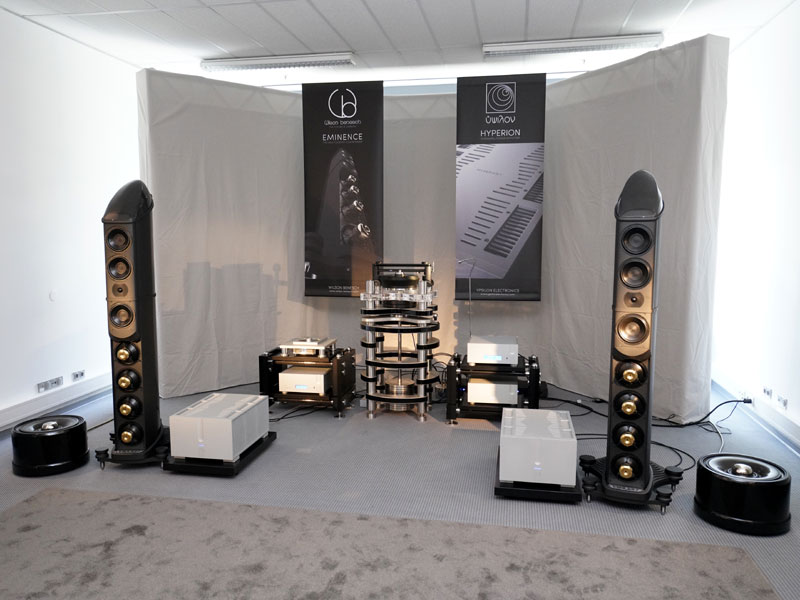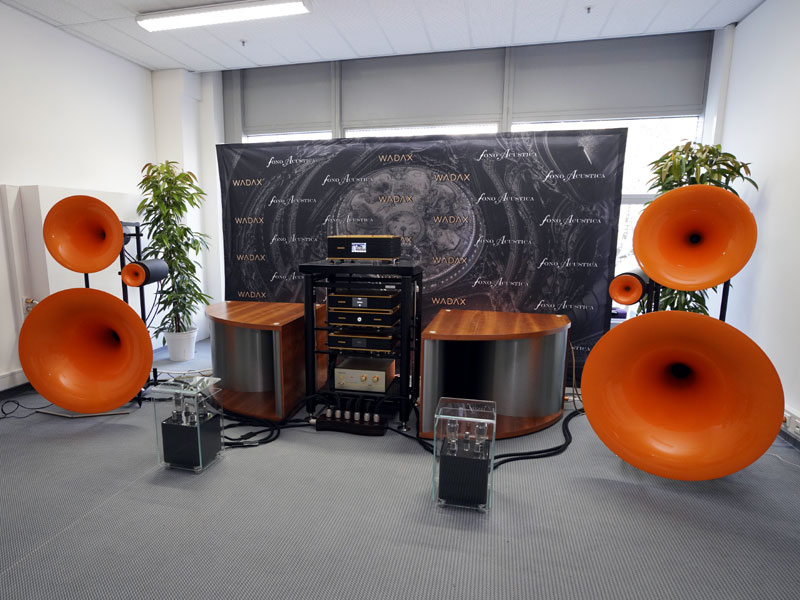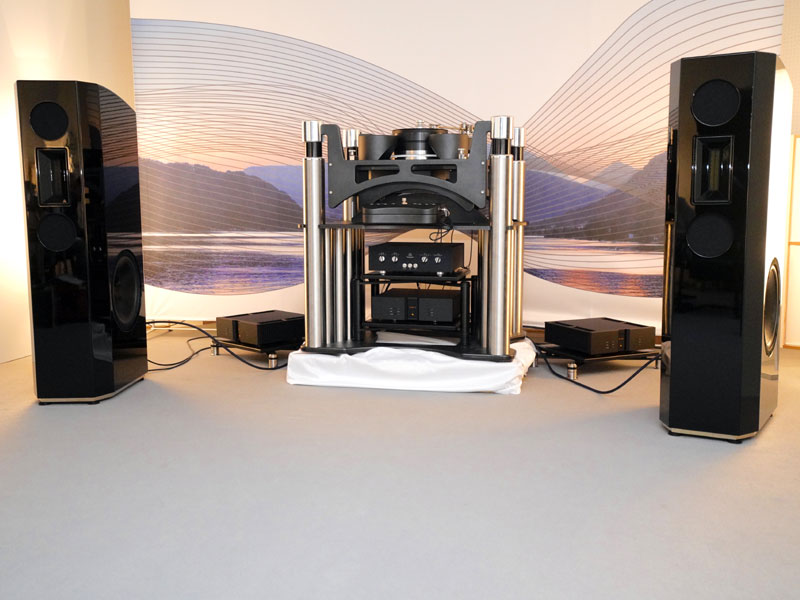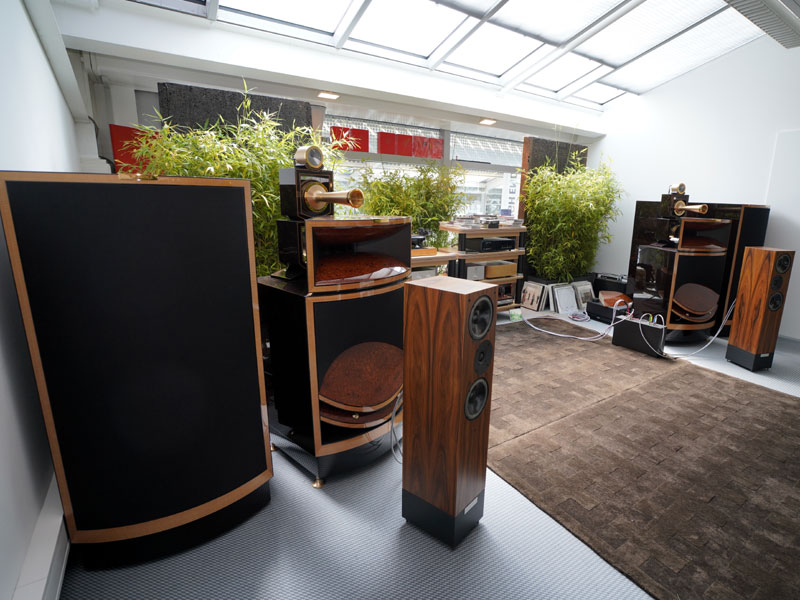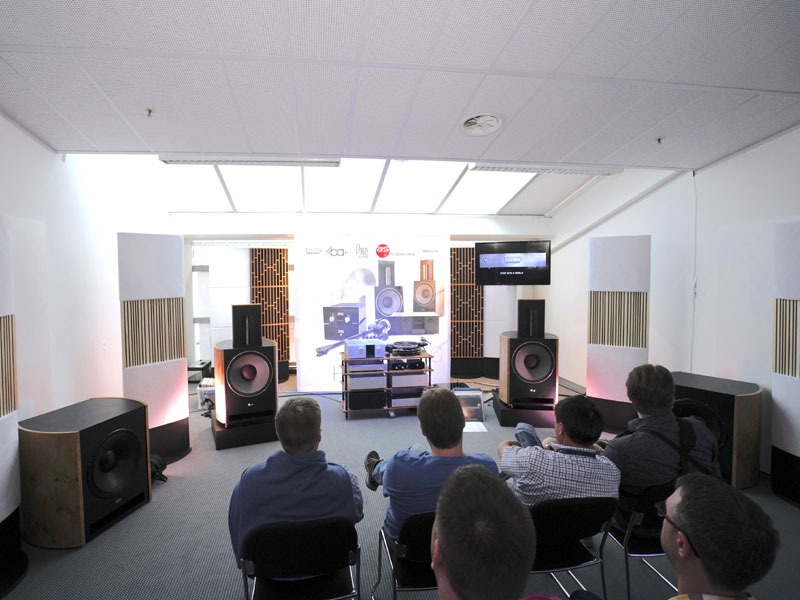High End 2018 • Back in the Munich Groove
Each show, and each Munich show in particular, seems to develop an almost independent, occasionally subversive subtext, an underlying theme that bubbles up from the audio industry’s subconscious. Last year, that herd instinct could be characterized by the almost tangible air of anxiety and uncertainty. This year, despite the number of speakers you could live in and the systems with more boxes than an IKEA warehouse, the key underlying trend seemed to be one of downsizing, with noticeably successful systems on show from companies specializing in high-performance, high-value equipment rubbing shoulders with scaled-down offerings from those best known for unabashed assaults on the state of the art (as well as their customer’s personal finances). If Wilson Audio has gone tabletop with the TuneTot, they’re not the only company looking to offer a taste of champagne sound on something at least approaching a beer budget.
Possibly the most significant entrant in the budget-esoteric stakes was Cambridge Audio. Cambridge is best known for its budget electronics, but what few people realize is that the familiar "designed in Britain, built in China" model that has become so prevalent amongst the UK’s classic audio brands reaches a new apogee with Cambridge. Now entering their 50th year as an audio company, Cambridge's London offices accommodate more than 40 design and engineering staff, an astonishing total in the small-business world of high-end audio. That and significant financial muscle give them the opportunity to take on and conquer some serious engineering and design challenges -- which helps explain the both the price and performance of the new Edge-series electronics. The first surprise comes with the name, which far from being a marketing-driven suggestion of cutting-edge performance or something equally nebulous, actually honors Professor Gordon Edge, one of the company’s founders. These amps were first seen in prototype form at last year’s Rocky Mountain Audio Fest; Munich saw the finished products on show, featuring beautifully executed curved fascias, chassis tops that visually float within their perimeters and the sort of gracefully minimalist styling that most high-end companies can only dream of. There are three products in the range: the Edge A 100Wpc, USB and Bluetooth capable integrated DAC and amplifier; the Edge NQ network-capable DAC and preamplifier (above, top shelf) and the Edge W 100Wpc stereo power amplifier (bottom shelf). All offer both balanced and single-ended connections and each is loaded with the latest streaming technology as well as clever audiophile touches, such as mirror-wound toroidal transformers to eliminate hum and power amplifier circuits flooded with a standing bias voltage to eliminate the audible effects of switching distortion (an approach similar to that used so successfully in the Avantgarde amplifiers). The sound at the show, in a pre-fabricated room with a system comprising the Edge NQ and a pair of Edge Ws biamping notoriously difficult B&W speakers, was crisp, clean, transparent, spacious and seriously dynamic, suggesting that the claimed doubling of output into a 4-ohm load is more than just an optimistic dream. Which brings us to the second surprise -- those prices: £5000 for the Edge A, £4000 for the Edge NQ and £3000 for the Edge W. That makes the integrated amp look like a major bargain, while the Edge NQ/W combination offers the addition of Chromecast, the excellent proprietary StreamMagic software and improved signal-to-noise performance. Even under show conditions, these electronics managed to offer both a standout performance amidst the general mediocrity of streaming-based systems and more than a hint of serious high-end performance, period. I’m seriously keen to get them into a known environment and a more ambitious system context just to see how far they can be taken. The £10,000 price for an impressively capable four-channel system looks like an awful lot of music for the money and an electronics stack that might partner with some serious speaker systems.
Which brings me to a pair of exotic loudspeaker offerings. First up, Tidal played its spin-off Vimberg Tonda (€28,000/pair), the larger of two models, on the end of a complete set of Tidal electronics -- Camira DAC (€25,000), Presencio line stage (€39,000), Ferios monoblocks (€49,000/pair) -- fed from an Esoteric P-02x transport (€20,000) and laced together with Tidal cables. The "stand" was a modified USM cabinet, further underlining the domestic sensibilities of the speakers and adding to the compact, attractive presentation of this system. I’ve covered these speakers (and the thinking behind them) in a separate blog, but this is the opportunity to place them in a wider context. With three days more running time and the experience of more than a few outwardly similar but vastly more expensive alternatives, the sonic virtues, musical capabilities and sheer value of the Tondas were underlined in bold. Okay, so the driving system is pretty extravagant, but even so the speakers delivered an impressive sense of coherent space, dramatic dynamic contrasts and shifts in density, impressive stability and musical authority -- all without ever shouting or becoming overbearing. They may not offer the sheer instrumental dimensionality, or the richness of the harmonic and tonal palette you’ll get from the Tidal Akiras (stood alongside in the pictures), but then that might come and they do only cost one-sixth as much. What the Tondas do have is the same fluid grace and expressive temporal grasp that makes the Tidal speakers so engaging and communicative. Despite their obvious resolution and clarity, they delivered Lisa Batiashvili’s Tchaikovsky with a beautiful sense of flow, progression, proportion and perspective, her playing delicate, expressive and emotive, devoid of the cool sterility that so often infects the ceramic-driver-equipped competition. Capable and credible, this is a speaker that will be right at home (and grow with) a set of seriously high-end electronics, yet has the innate musical qualities to thrive on the end of a quality integrated amp, or embrace the underpinning provided by an equally capable subwoofer (or two).
All of which leads me directly to the Stenheim Alumine Five Signature. At €75,000 per pair, this speaker doesn’t exactly inhabit bargain-basement territory, representing as it does a near 50% increase in price over the already excellent Alumine Five. Along side the slimmer but taller Tonda it looks expensive -- but looks can be deceptive and the real significance of the Signature model is not so much what you get, but the potential options it opens up. Compared to the standard model, the Signature offers a massive, machined three-point base plate, leather damped baffle, Brandt internal wiring and an upgraded external crossover, revoiced by producer Jean-Claude Gaberel (who has consulted on the other Stenheim designs) -- hence the Signature designation. Driven from a Nagra CDT transport (€15,000), a Manufacture Le Son LS001 streamer/DAC (€25,000), Mastersound Spettro preamp (€12,000) and PF100 Litz Edition mono-blocs (€38,000) and Brandt Audio cables, the sound was relaxed, open and effortlessly unforced, with natural tonality and expressive dynamics -- all the things that I’ve come to love about the standard Alumine Five, a speaker that really lets the music breathe. But what the Signature adds is greater resolution, transparency and authority, without undermining the musical qualities that make the standard Five so addictive. Playing the Testament live CD of the Du-Pre/Elgar Cello Concerto, the playing was delicate and expressive when needed, explosive and vibrant on demand. The size and character of the Cello was captured perfectly, while Barbirolli’s masterly direction and control of pace was even more apparent. The soundstage was vast and utterly independent of the speaker cabinets, making this one system that was incredibly easy to forget -- in the best possible way, of course. All of which is good stuff, but it only chips the surface of what the Five Signature offers, because the really intriguing thing about this speaker is the way in which it can grow. Stenheim’s other new product at the show was the Alumine Sub, a more compact option seen and heard reinforcing the bottom end of the Stenheim Ultime Reference Infinite speaker system employed on the end of the massive TechDas/CH Precision system several doors down. Each low-slung, rectangular, damped aluminum cabinet contains a pair of horizontally opposed 13" drivers and follows the format established by Wilson’s WATCH Dog, with an external active crossover. But outside of the Reference Infinite system, the subs can be purchased separately for €24,000 each -- a readymade expansion option for the Alumine Five. But that’s not all. The external crossover that feeds the speaker itself can be replaced by a dedicated version of the active unit already used with the Ultime Reference. Details of trade-up options on the passive crossovers remain to be announced, but the choice to take the Statement active, with or without subs, is simply mouth-watering, promising an astonishing sense of scale and dynamic range from what is a remarkably compact floorstander. If the dramatic musical benefits of taking the Ultime Reference active are any indication, the active Alumine Five Statement could become the most famous giant killer since David strolled out to meet Goliath.
Neodio has always produced astonishingly impressive results from their outwardly simple four-box systems, and this year was no different. Making your own, extremely capable cables and supports certainly helps, but even so, the results generated by the Origine S2 CD player, A2 amplifier (recently reduced to €15,000 each) and a pair of Kelinac KEL 914MG speakers (€8000/pair) was wildly out of proportion with the overall cost of the system -- and in a different value universe to the rest of the systems in Munich. Agile, articulate, musically communicative and with an innately natural sense of spatial and temporal proportion, this almost affordable setup shone a stark light on the disjointed, flattened and bleached-out efforts of so many of the most expensive systems on show. The sensitivity, elongation and poise of Batiashvili’s achingly beautiful opening line hung, fragile yet emotionally powerful in the air, an object lesson in just what a high-end audio system can and should achieve. To do so from such stylish and modestly priced components (at least in the context of this show) keeps Neodio at the absolute forefront of CD replay and system performance -- irrespective of price. In a world where genuine bargains are so rare that they are treated with suspicion, Neodio’s Origine S2 CD player is the most musically compelling bargain I’ve come across, a status it has maintained and now reinforced with its recent significant price reduction.
This list wouldn’t be complete without the Grand Prix Audio/CH Precision/Apertura system we were lucky enough to use for our record-replay EQ presentations. The speakers were a pair of Apertura’s two-way Edena Evolution (€7890/pair in standard finish, €8250 for high-gloss versions), whose angled baffles and teardrop footprint hinted at hidden subtleties under the distinctive lilac paintwork (wood veneers are also available). Apertura pays considerable attention to the mechanical behavior of the cabinets, including the provision of a central grounding cone, with the easily adjusted outrigger spikes deployed around it. These were paired with CH Precision’s I1 integrated amplifier (CHF 33,400 plus CHF 4800 for the phono cards), an expensive but incredibly capable and versatile performer. One aspect of that versatility is the ability to allot any or all of the three RCA analog inputs as a phono input, including the provision of those all-important EQ curves (at least as far as our presentation or anybody playing '60s, '70s or '80s pressings is concerned): RIAA, EMI, Columbia, Decca and Teldec cover most of the bases. Source? Although we employed a Monaco v2.0 turntable ($36,500) for the presentations, a second Grand Prix rack flanking the I1 on the other side supported the more affordable Parabolica ($16,500), equipped with the same Kuzma 4Point tonearm ($7080) and Fuuga cartridge ($8975), a setup that let you hear just how close the "budget" deck gets to the flagship. Back-to-back comparison showed that the Parabolica may not be a Monaco, but it gets impressively close given the difference in price -- a price that places the deck at least almost adjacent to the Neodio Origine S2 CD player. The Parabolica/I1/Edena Evolution combination in many respects represents each company’s second string, yet the confident clarity, coherence and dynamic integrity on show were as engaging and lucid as they were musically enjoyable, a system that could really bring the best from a serious record collection.
Of course, there were big systems that were out to impress too. As is often the case, these were massive and massively complex, although few matched the sheer enormity of the Goebel Divin Majestic rig. Starting with the Kronos Pro turntable ($38,000), SCPS1 power supply ($13,500), Black Beauty tonearm ($8500), ZYX Universe pickup ($16,500) and Kronos Reference Phono Pre ($45,000), the signal was fed to the CH Precision C1 DAC/preamp ($32,000) with T1 Clock ($28,600 including GPS module) and X1 dual external supply ($17,000). In turn it then reached a pair of the M1 stereo amps ($54,000 each) before finding its way into the massive Goebel speakers (€377,310 the pair -- or €450,000 including tax). The whole lot was laced together using Goebel Lacorde Statement cables (€2521 each, or €5042 per pair), and there was a CH Precision D1 CD/SACD transport ($38,000) in the mix too. That’s quite a laundry list, which gives you a sense of just how ambitious and extravagant some of the systems in Munich are, although even by the standards of what is the world’s most important show, this year was somewhat unusual, as many of the established exhibitors upped the ante. Quite a departure from Goebel’s more familiar, slender baffles with their waisted profile and multiple identical bass drivers, the biggest story here (or at least the most obvious) was the sheer size of the new Divin Majestic. The cabinets are actually stacked up, a central section top and tailed by identical bass enclosures, in a similar arrangement to Rockport’s massive Arakis. Perhaps the best indication of their enormity is the fact that those boxes on the floor next to them are CH Precion’s far from petite M1 amplifiers. These speakers are large -- actually, make that huge. Less obvious is -- mainly because you are distracted by the monstrous size and striking shape of the speakers -- Goebel’s move away from their signature, wide-bandwidth bending-wave driver. Instead, the Divin Majestic employs a large AMT driver, flanked by a pair of large but conventional midrange drivers. The sound of this system delivered huge scale, presence and power -- no surprise there. But what was impressive was the combination of agile dynamics, focus and transparency, which allowed the speakers, vast as they were, to effectively disappear. The Analogue Productions 45rpm pressing of Farmer’s Market Barbeque displayed shifts in musical density and sudden dynamic demands delivered with effortless, almost contemptuous ease. The bass was notably rich and a little plumy -- hardly surprising under show conditions -- but still devoid of drag or overhang, meaning the music lost none of its pace or immediacy. While the charms of the earlier Goebel Aeon models have tended to pass me by, the Divin Majestic got my attention in no uncertain terms.
Magico was another company delivering a surprise package, not so much in the shape of their impressive M6 loudspeaker ($172,000/pair), its carbon sandwich cabinet such a departure from their previous aluminum designs, but in the source used for the driving system. Not only was Magico playing records, but they were playing records brought by show visitors. This is such a departure from the ultra-controlled nature of their streaming-only systems used at previous shows that it alone is worthy of note. A Kronos/ZYZ record player was used to feed Soulution electronics in the shape of a 755 phono stage ($72,000), 760 DAC ($50,000), 725 line stage ($50,000) and a pair of 701 monoblocks ($155,000/pair) all housed in an HRS RXR rack and amp stands with R-shelves and a mix of Vovox and MIT cables. Playing the Warner reissue of the Martha Argerich/Abbado/BPO, Prokofiev Piano Concerto No.3, this system delivered a real sense of musical authority, stability and weight combined with the sort of attack and separation that make pattern and phrasing as explicit as they are expressively effective -- exactly the musical qualities demanded by the drama and contrast in this performance. This was by far the most enjoyable and engaging performance I’ve heard from big Magicos, and I suspect that the choice of source had more than a little to do with that.
Raidho, a company that continues to rise, phoenix-like, from the ruins of its recent past, delivered the third of our surprise packages. Following hard on the heals of the extremely impressive XT5 model launched at last year's Rocky Mountain Audio Fest, a speaker that is both significantly more affordable and far better balanced than any of their previous floorstanders, the new design team has released a genuine flagship in the elegantly slim shape of the TD 4.8 (€134,000/pair in piano black, €149,000/pair in lacquered walnut-burl veneer). Taking styling cues from both the D5 (the central "cheeks" with their oval rebates) and the D4 (the aerofoil shape and rear-firing, vertically disposed "jet pipes") the "TD" in the designation denotes yet another advance in Raidho’s ceramic sandwich-cone technology. Starting with their standard C-series thick-skin ceramic diaphragm, the basis for all their bass and midrange drivers, the surface is twice bombarded with Tantalum molecules in a high-temperature plasma process, before coating with their proprietary diamond layer, resulting in a cone that is both stiffer and better damped than previous D-series drivers. Each TD 4.8 flanks the familiar Raidho tweeter with a symmetrical array of two midrange drivers and four bass units, the latter reflex loaded via the five rear-facing ports, the tall cabinets given stability by the substantial outriggers that support the feet. Also part of the system was a suite of Chord Electronics units: the Blu Mk 2 transport ($11,788) DAVE DAC ($12,488) and CPA5000 line stage and SPM6000 Mk. 2 mono amps ($66,900 the set), all wired with Nordost’s second-tier Valhalla 2 and supported on Raidho’s own racks. This was another CD-based system that was a refreshingly vibrant and colorful break from the drab, flattened, grainy gray of the vast majority of streamer-sourced systems. From the first notes of the Batiashvili Beethoven Violin Concerto, it was immediately obvious that this setup possessed an unusual sense of presence, body and immediacy. As agile and dynamically lucid as Raidhos always are, the DT 4.8 put some much needed flesh on the musical bones, with bass that was deep, tuneful, quick and really well integrated, bringing dimensionality to images and authority to the performance. Despite a flattened soundstage (courtesy of the curved branding panel immediately behind the system, one suspects) this was a seriously enjoyable and musically entertaining system, one that never put its significant sonic virtues ahead of the musical message, instead harnessing them firmly to its service. The new team at Raidho have made quick work of building on the brand’s traditional strengths and eliminating the all-too-obvious flaws in their bigger speakers, the considerable potential that was always obvious in their driver technology finally coming to fruition and matching the stellar performance of the smaller, two-way models. Always one to watch, Raidho is finally delivering on all that promise.
Two companies that are central members of the usual suspects when it comes to great sound in Munich are up next. The Vandersteen, Brinkmann, HRS room was an oasis of musical calm, a welcome return to form after the tribulations that afflicted them last year, where late equipment swaps upset the weight-specific HRS isolation strategy. No such problems this time round, with the Brinkmann/Vandersteen combination delivering its usual relaxed, unruffled yet musically communicative performance. After a rare outing for the Vandersteen Quattros in 2017, this year saw the return of the Model 7s ($62,000/pair), running without subs and driven by the Brinkmann Edison Mk II phono stage ($13,990), the new Marconi Mk II line stage ($13,990) and a pair of Mono power amps ($19,990/pair). Sources were the Nyquist Mk II DAC ($17,990) or our choice, the 33rd Anniversary Edition of the Balance turntable (price still to be fixed) equipped with two 12.1 tonearms and Brinkmann cartridges. Racks were HRS’s flagship, super-solid VXR frames and the latest M3X2 platforms. Playing the Basie tracks again, there was impressive energy and projection in the solos, a solid sense of presence and purpose in the band. Perspective was notably natural, with no stacking or elevation of elements within the band, while the note weight and subtle rhythmic pushes and accents of Basie’s piano were beautifully graduated, fitting seamlessly into the whole. This was unforced, unexaggerated and yet still tight and propulsive -- exactly as a great big band should be, and this was a great big band! Moving through other tracks and genres demonstrated exactly why this has always been a go-to system for good sound and great music, the system possessing a relaxed sense of pace and planted stability that let it get out of the way and the music to speak for itself.
Meanwhile, anybody who reckoned that the Wilson Benesch Cardinal was a little modest for a flagship, in terms of size, price and material content if not performance, could either pat themselves on the back for the prescience or conclude that perhaps they should be careful what they wish for. Given the proprietary materials, entirely in-house design and sheer engineering content in their loudspeakers, I think that Wilson Benesch could fairly be accused of hiding their light under a bushel -- at least in years gone by. That all changed in Munich with the arrival of the new Eminence Reference loudspeakers (€165,000/pair in standard finish) the Cardinal’s (much) bigger, badder brother. At getting on for twice the price of the previous flagship, but sharing its overall presentation and appearance, you might well wonder what justifies the price hike, other than a few extra drivers and a little extra height. Despite its outwardly familiar appearance, Eminence actually contains three significant technological advances, marking the introduction of the Tactic 3 drivers, an entirely new carbon sandwich for the cabinet and a complete revision to the company’s Semisphere tweeter, in turn promising improvements in system integration, linearity and clarity, especially important given Wilson Benesch’s reliance on mechanical roll-offs between cone drivers and a minimal crossover for the tweeter. The extensive application of composite grown parts has been a significant part of this story, yet more evidence of the benefits accruing from Wilson Benesch’s association with the Sheffield AMP. Of course, the proof of any audio pudding is in the eating and the Eminence Reference didn’t disappoint. Paired with Ypsilon electronics (CDT-100 transport/player, €16,500; the new DAC 1000, €17,000; PST-100 Mk II SE preamp, €32,000; and Hyperion mono power amplifiers, €68,000 the pair) as well as a pair of Wilson Benesch’s Torus subs and matching amps (€10,780 and €7980, respectively) the sound was quick, clean, lucid, organized and transparent, without ever pulling the music apart. A lot of the credit for that rests with Ypsilon’s new DAC, the CD front-end offering an exceptionally fluid and expressive performance, while the Torus subs helped ensure that there was body, weight and acoustic space aplenty. Subs? With a speaker of this size? Absolutely! In fact, just as with the Cardinal, I’d consider adding the Torus to the Eminence as a no-brainer -- not because the speaker is short on bass, but because of what the added bass brings to the party. The massive expanse and ultra blackness of the acoustic space generated and mapped by this system were no accident, and they brought a real sense of presence and immediacy to recordings. Cueing up the Batiashvili Tchaikovsky disc once more, we were immediately struck not just by the clarity and poise in the presentation and playing, but the sense of time, the unforced and unhurried ease with which the performance simply unrolled before us. The natural sense of scale and dimensionality played a big part in that, but it was the way this system allowed the soloist’s expressive measure and full range that made it really special. When Batiashvili stretches out the opening bars of her first entry, far from slowing proceedings it introduces a tingle of anticipation, an air of expectancy that the Wilson Benesch/Ypsilon setup captured perfectly. Nor was it just the delicate end of the spectrum that was well served, with the musical drama and explosive dynamics of the performance delivered with the sort of contained gusto that makes for rewarding long-term listening. This was the first time I’ve heard the Ypsilon electronics live up to their reputation, but then this is also by far the best speaker I’ve ever heard from Wilson Benesch.
Another safe bet for good sound has always been the Wadax/Fono Acustica room and again it didn’t disappoint. The thing that makes it interesting is the fact that with the room owners providing source and cables only, the rest of the system tends to be a moveable feast, with products as diverse as Wilson and Avantgarde, Stenheim, VTL and Audio Research all featuring in recent years. This time around, it was all change from last year’s excellent VTL/Stenheim set up, with the Wadax flagship Atlantis line digital front-end paired with a Robert Koda K-15 line stage ($58,000) and Engström Lars 300B monoblocks (€68,750/pair), driving a bright-orange set of Avantgarde Trios, with a pair of matching bass bins (€60,588/pair). Cabling was predominantly Fono Acustica’s top-of-the-line Virtuoso, but with the new Armonico RJ45 (price to be announced) also making an appearance, along with several of the latest Armonico power cords (from €5500 each). Atlantis made its debut last year and is already establishing itself as the preferred digital platform for well-heeled audiophiles, especially in the Far East. While the long-awaited phono stage is still to appear, the show system used production examples of the Universal Transport ($45,000, based around a proprietary disc drive and with the option of an audio and full 4K video output upgrade for an extra $8950), Universal DAC ($69,000 with the option of an MQA board at $4950) and the Universal Server ($20,000 with native DSD replay and all the usual file replay capabilities). That makes for a veritable stack of gold-and-black hardware, a pretty ostentatious statement that needs to be backed up with some serious musical attitude and cojones. Fortunately, the Wadax electronics have never lacked for those qualities, the proprietary Music2 digital feed-forward error-correction algorithm that is the heart of the system building on the already standard-setting performance of the original MusiChip. It’s not hard to hear just what sets Atlantis apart from other, more conventional digital replay solutions, and the rest of the setup did nothing to mask its capabilities, the agility and articulation of the Lars perfectly suited to the lightning quick clarity of the Avantgarde speakers. Meanwhile, the Robert Koda preamp quietly got on with the job of anchoring the whole rig, leaving me with serious respect for this unit from a legendary brand, but one I’ve never experienced at home. I visited this room on a number of occasions and it was one of the venues where you could enjoy the live MQA concert feed on Saturday afternoon. However, by far the most interesting and impressive display was an impromptu glass CD presentation by Andy Lamm, one of only two manufacturers of the rare but wonderful format. Using a Denon recording of the Dvorak New World (Vaclav Neumann and the Czech P.O.), we were able to here a standard CD version, a UHQ CD version (that uses the same photo-optic interface layer as glass CD, but paired with a hard-plastic skin) and finally the glass CD proper. Once again, the steps up in sonic and musical quality were obvious, the supremacy of the glass disc brutally apparent and made even more so by a second comparison, a Chinese/Dutch musical collaboration whose beautiful recording really showed off the coherent soundstage and focus of the Trios -- not to mention their impressive dynamic range. If it’s hard to get multi-cell horns to work under show conditions (and there was plenty of evidence of that in Munich this year) the sheer musical coherence of the Atlantis front-end, its spatial and temporal integrity, was a great place to start, aided and abetted by the musicality and natural warmth of the Fono Acustica cables and Engström amps. This was one stellar lineup that actually delivered stellar results.
There were two systems that achieved truly memorable results this year, the kind of results that you remember for a long time afterwards. Last year Acoustical Systems stunned everybody by showing their massive APOLYT turntable (€270,000). This year they went one better and played the beast, equipped with their own AXIOM tonearm (€15,800) and Palladian cartridge (€8800). Air-suspended and with an air bearing, the turntable offers a choice of belt or idler drive, with belt being selected in this case. Sadly (although perhaps not surprisingly given the weight and complexity of this monster) transit had taken its toll, neatly snipping two of the suspension hoses, meaning that the ‘table was relying on its sheer mass and decoupled platter to isolate the record. Despite this handicap, it still turned in a stunningly impressive performance. The system’s electronics comprised their own EVOcator phono stage (€33,800) paired with a Vitus Audio SL-103 line stage (€21,000) and SM-011 monoblocks (€41,000/pair). Cables were a mixture of top-flight AudioQuest and Acoustical Systems’ own designs, hooked up to the Soundspace Systems AIDONI speakers (€360,000/pair), on which Acoustical System’s Dietrich Brakemeier had considerable input. Substantial three-way designs, with a horn-loaded AMT tweeter, flanked by open-baffle midrange drivers mated to a pair of sideways-firing 15" bass units, these imposing boxes deliver a claimed efficiency of 101dB, coupled to a bandwidth of 18Hz to 32kHz. Placing such large and potent speakers in a prefabricated booth was always going to be risky, but judicious application of acoustic treatment and the room’s natural venting succeeded in offering up a genuinely remarkable performance of astonishing transparency, focus and stability. I don’t think I’ve ever heard such planted images or such an incredibly grain-free blackness behind the instruments, while the acoustic space was seamless and expansive, with a real reach-out-and-touch quality. Not surprisingly, dynamic range was emphatically convincing, the presence, solidity and immediacy of the performers giving the music a rich, vibrant and vivid sense of life and vitality. Acoustical Systems have opened a purpose built studio to demonstrate the APOLYT, presumably in a system very similar to this and, if the show performance was anything to go by, it will be well worth a visit.
Which brings me finally to our unanimous choice for the best sounding and most enjoyable system at the show. Once again, Living Voice wowed the crowds with a room featuring their extraordinarily expensive Vox Olympian/Vox Elysian speakers, Kondo electronics and, for the first time this year, alongside their regular CD source, a record player in the shape of the Grand Prix Audio Monaco 2.0. The full system list makes for a daunting, wallet-crunching, pip-squealing read, but here it is: Vox Olympian/Vox Elysian speaker system, £750,000; two pairs of Kondo Gakuoh 300B amplifiers (with Living Voice 300B tubes), £70,000/pair; Kondo M77 preamplifier, £40,000; Canary Audio LV CD300 CD player, £7500; SJS enhanced Model 3 phono stage, £14,000; Living Voice step-up transformer, £6000; Kondo SFz step-up transformer, £8700; Grand Prix Audio Monaco v2.0 turntable, $36,500; Kuzma 4Point tonearm, $7,080; Fuuga cartridge, $8975; Rigid Float RF7 carbon tonearm, £4,150; and Ortofon SPU A85 cartridge (now discontinued); Living Voice G2 equipment tables, £28,800 each; assorted Kondo and Living Voice cables; and, of course, the Living Voice Pure Music battery power supply to drive the whole thing, £25,000. By any standard, that’s quite a list to live up to, but judging by the eager faces on the listeners being seduced, impressed, beguiled and besotted by this remarkable array of equipment, this was one system that had no problem justifying its extravagant price tag. Except that, despite all the visual evidence to the contrary -- and the Vox Olympian/Vox Elysian pairing is kind of hard to miss -- the sound that was (almost literally) blowing people away was actually coming from the £11,000 OBX-RW3 floorstanders stood in front of the horns. The disbelief and astonishment on listeners' faces when they realized that it wasn’t the horns they were listening to at all, but a pair of surprisingly compact, astonishingly affordable and domestically house-trained and utterly conventional loudspeakers was worth the entry fee alone. Time and again you could literally see the penny (and very often the jaw) drop. And not just the public. More than a few reviewers and show reporters were caught unawares, including one video crew who fell into disarray after the front man had delivered a florid explanation of the Vox Olympian’s magnificence only to have it pointed out that it was actually the OBXs playing. "Cut! Cut! Cut!" was followed by a lot of expletives I couldn’t possibly quote. But amusement value aside, what made this system so impressive was its sheer musical integrity, its easy dynamics, engaging sound and captivating presentation. It didn’t just fool people visually, it really did sound that good and that convincing, which is no mean feat at the price of the speakers. Okay, so biamping with Gakuohs gives them a serious leg up, but even so, this was no ordinary performance. The sound of the Argerich Prokofiev piano concerto was vivid, fluid, explosive and expressive, giving shape and subtlety to a performance that most systems struggle with. It may not have had the bandwidth and acoustic stability of the Magicos, but its musical authority, sense of purpose and compelling quality was never in doubt for an instant. The Monaco 2.0’s dynamic and temporal precision conjured Argerich’s artistry out of the thin air between the speakers, revealing exactly why she exploded onto the classical music scene, captivating audiences and critics alike. Abbado puts in an impressive turn too, demonstrating that there’s more than just midband coherence to the OBXs. Indeed, it was the bottom-end shape, weight and impact that seemed to fool most people into thinking that they were hearing the big speakers. John Eliot Gardner’s Beethoven Fifth (from his Archiv boxed set with the Orchestre Révolutionnaire et Romantique) was just as impressive, channeling the mighty Kleiber in its energy and dynamic vigor, with the performance holding the audience spellbound for the entire symphony. Impressive indeed, but not as impressive as the fact that with the Vox Olympian/Vox Elysian pairing waiting in the wings, Living Voice felt no need to look in that direction -- and nobody in the audience was asking them to. Everybody was so busy enjoying and marveling at the OBX-RW3s that the notion of changing them out in favor of the big horns simply never occurred. It also demonstrates categorically that Living Voice is more, much more, than an extravagantly priced one-trick pony. The selective and exhaustive approach that extracts all that performance from those million-pound systems, even under show conditions, is just as applicable at less exalted price points. At a show notable for the impressive performance of major manufacturer’s minor offerings, this was perhaps the ultimate example of downsizing. Living Voice: living proof that it’s not what you use but how you use it that counts.
When you are trying to use an SPL meter to set levels for a detailed comparative demo and the peak output from your system is swamped by acoustic breakthrough from the room next door, you know you are in trouble. If proof were needed that in the vast majority of cases, DSP room correction invites abuse and all too often equates to musical deconstruction, here it was.
This was a room and a system that offended on multiple levels, not just playing ridiculously loud, but using the most hackneyed and clichéd of audiophile demo tracks to do it. "Tin Pan Alley" and "Stimela" over and over again? Really? Whoever was running this completely amusical cluster was clearly as devoid of musical inspiration as they were of social sensibilities. Even at an event bedeviled by
low-frequency excess and too many lead fingers on the volume control, this system stood
out for not just the nature of the offense it caused but the constancy and blatant
indifference with which it caused it. |

